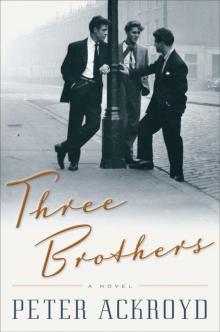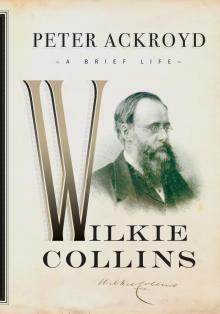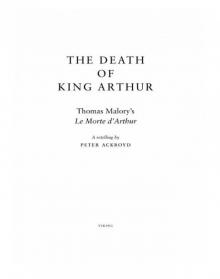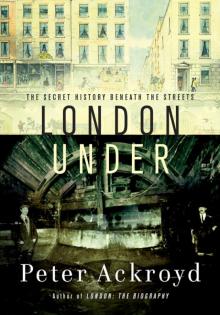- Home
- Peter Ackroyd
London Under Page 6
London Under Read online
Page 6
A recent traveller went beneath Piccadilly in 1960 where “down below it was like crossing the Styx. The fog had followed us down from the streets and swirled above the discoloured and strongly smelling river like the stream of Hades.” Another traveller described the Fleet sewer when seen fitfully by the light of the lanterns as “one of the prisons designed by Piranesi.” That is one of the fears of walking under the ground; you may be trapped and imprisoned by the weight of the darkness. Sewers might induce fear and even hysteria.
The reports of the world beneath are written in a generally breathless tone, compounded of fear and awe. The underground chambers are compared to cathedrals, complete with pillars and buttresses, arches and crypts. One visitor, discovering an archway through which a cataract tumbled, remarked that it was as fantastic a scene as “a dream of a subterranean monastery.” The travellers walk along tunnels that may reach a height of 17 feet, the cool tainted water lapping at about knee-height around their waders. Many are disconcerted by the pull of the water, and feel disoriented; they lose their equilibrium. They feel the sediment beneath their feet, as if they were walking on a beach at low tide. Great iron doors loom up at intervals, acting as valves. The noise of roaring water, somewhere in the distance, can generally be heard. It is the sound of cataracts and waterfalls. Yet the sounds of the outer world—the general roar and tumult of London—can also clearly be heard from the ventilator gratings in the roads above.
The travellers journey through great brick vaults where the various sewers join together. If they are unfortunate they might pass great deposits of fat fastened to the sides of the tunnels, some of them 30 or 40 inches thick; they have accrued from the ingestion of deposits of “fast food.” Rats can occasionally be seen. They were more plentiful in the nineteenth and twentieth centuries, in what were known as blood sewers; these were the sewers under slaughter-houses and meat-markets.
The smell is sometimes offensive but often simply musty, with the odours of damp and stone; the atmosphere is close and clammy. A mist may hover over the turbid liquid. The vistas of brick in these curiously egg-shaped tunnels stretch ever onward. It would be easy to get lost. It would be easy to remain concealed. Some of the sewers have not been visited in the last fifteen years.
One nineteenth-century traveller reported that he saw, in an old sewer under Blackfriars Bridge, “a cluster of mushrooms on the roof that were almost as large as ordinary soup-tureens.” On 28 July 1840, the first visitor to the newly bricked Fleet sewer descended at Fleet Bridge. “I suspended my argand lamp on the breakwater of the sewer, and with my lanthorn light we proceeded towards the Thames.” It might be a narrative from the swamps of Borneo rather than the City of London. The sewer turned and twisted when suddenly, at a quarter to midday, they realised that the tide had come in to a depth of 2½ feet. He and his companions were in fear for their lives and “holding our Lamps aloft, dashed up the Sewer, which we had to get up one half before out of danger. The air was close, and made us faint. However we got safe to Holborn Bridge.…”
In A Traveller’s Life Eric Newby reflected on a journey within the Tyburn sewer in the early 1960s. He was told to be alert to the presence of acetylene, petrol, carbon dioxide and hydrogen cyanide with “a nice smell of almonds, the faintest suspicion of which sent any gang of sewermen” straight back to the surface at a very fast pace. Yet what caught his nostrils was the odour of coal gas, from leaking pipes, mixed with the unmistakable smell of untreated sewage. He noticed in the course of his journey families of rats nestling in broken brickwork. They were known to the sewer-men of the time as “bunnies.” Newby was then taken into the Fleet sewer, where he was confronted by a warm and steamy darkness “rather like a Turkish bath with something wrong with it.”
A visionary work of modern times, in the spirit of Bazalgette, is now being undertaken. The Thames Tideway Tunnel will run from Chiswick in West London to Beckton in East London, a distance of some 20 miles. It will carry away the sewage and excess waste that accumulates after heavy rain, catching it before it reaches the river. It is being built 200 feet beneath the surface, following the sinuous course of the river, and must rank as one of the largest engineering projects of recent times. It is hoped to be completed by 2020. Yet, as in all matters of the underworld, it is not widely known or discussed.
Two other tunnels of water pass beneath London. A canal runs for three-quarters of a mile underneath the streets of Islington, snaking below Muriel Street, Barns-bury Road, Tolpuddle Street and Upper Street before coming out beside Noel Road. The second tunnel under London, the Maida Hill tunnel, runs under Edgware Road and proceeds beneath Aberdeen Place for 370 yards. The work on the tunnel was done by candlelight, and was constantly bedevilled by the discovery of underground springs; the excavated earth was taken to “Mr. Lord’s field,” that later became Lord’s Cricket Ground.
The Islington tunnel was opened in 1820, and the first boats were propelled by “legging,” whereby men lay on planks and guided their craft with their feet and legs against the sides of the tunnel; they were replaced in 1826 by a steam tug that hauled the vessels through by means of a strong chain. There was a saying of the time, “nearly gassed but nearly through.” A journalist recorded that this transport:
has a truly tartarean aspect. The smoke, the fire, and the noise of the engine contrasting with the black gloom of the arch, the blackness of the water, the crashing of the vessels against the sides of the tunnel and each other, and the lurid light that glimmers beyond each distant extremity form an aggregate of infernalia that must be witnessed to be adequately conceived.
The tunnel was renovated in 2000, and is now of course the avenue of boats with engine power. The experience of the journey, however, is the same. The voyage takes approximately twenty minutes during which the voyager, on a barge or a small boat, has the uncanny sensation of sailing beneath the city. It is possible to see a small circular light at the other end of the tunnel but then the darkness descends, described by one traveller as “thick” and “sooty.” The tunnel has its own weather. A pilot in the days of the steam tug remarked that “when it’s foggy outside it’s clear in the tunnel. It’s a very queer tunnel.” The wind, in winter, blows very hard.
Ready to start “legging” in the Islington canal, 1930 (illustration credit Ill.18)
The sewers of London are now dangerous rather than deadly. The sewer-men work in teams under the command of a “ganger.” They have their own patois, a kind of underground language, by which they identify themselves and their colleagues in the often treacherous conditions. They are at risk from Weil’s disease, spread by rats, and from dizziness caused by working in the dark. They must also court the risk of explosion from the aggregation of gas or of drowning in a sudden storm of water. An hour’s thunderstorm may precipitate an inch of rain, which is equivalent to 100 tons of water per acre. The first sign of calamity is a fierce wind that blows through the tunnels. This is followed by the deluge rushing down into the storm-relief sewers, with a force strong enough to carry away anything in its path. Sewers can never wholly be trusted.
Opening a sewer by night, 1841 (illustration credit Ill.19)
By the thirteenth century, when some of the larger streams had run dry or had degenerated into open sewers, water was sent through pipes of lead; the slow dissolution of the metal must have had a noticeable effect upon the health of Londoners. In 1236 Gilbert de Sandford was granted “liberty to convey water from the town of Tyburn by pipes of lead into the City.” This Great Conduit, as it was known, ran down what is now Oxford Street. Conduit Street marks its passage. It then turned into Holborn before eventually reaching Cheapside where it was discharged from a great pump known as “the Conduit in Chepe.” A smaller conduit, built at the other end of Cheapside by Paul’s Gate, was called “the pissing conduit” by reason of its constant discharge of water. The system was, for the period, a remarkable feat of civil engineering, and the presence of the two conduits formed the emblematic centre of London a
t times of pageant or royal entry. They created a blessed space.
Other conduits were erected as the city expanded. White Conduit Street in Islington marks another source, while Lamb’s Conduit Street in Holborn commemorates the benefaction of Sir William Lambe. A conduit known as the Standard rose on Cornhill, and was a landmark of the city. These conduits also became the home of ritual, like most sites of underground water. The mayor and aldermen would visit each one in turn; “they hunted the hare and killed her” according to John Stow, before enjoying a feast “at the head of the conduit.” The banquet was followed by the hunting of the fox. These great pumps, however, proved to be a hindrance to the ever increasing traffic of the city; by the middle of the sixteenth century many of them had been removed.
The Cornhill conduit, 1800 (illustration credit Ill.20)
Other sources of water were also deployed, most notably in the New River built by Hugh Middleton at the beginning of the seventeenth century. This flowed from Amwell and Chadwell Springs in Hertfordshire into North London. A fountain playing at the corner of Rosebery Avenue and Arlington Way, where once Thames Water had its headquarters and where Sadler’s Wells still stands, marks its final destination. The shape of a great reservoir can still clearly be seen close by in Claremont Square. This is a very watery part of London. But the new river, like its older companions, has gone beneath the earth. It has been driven underground.
By the eighteenth century several water companies were laying pipes beneath the surface, with attendant problems of fierce competition and territorial struggle. Some London streets contained the pipes of three or four different companies vying for mastery. The companies joined together in 1811, but the subsequent monopoly did nothing to improve public health. Water flowed for very limited periods, sometimes as little as ten minutes each day, and there was no water on Sundays. Improvements were slow, gradual and random. Only at the beginning of the twentieth century, with the creation of the Metropolitan Water Board, was the public supply of water guaranteed. A huge water main was built, 19 feet beneath the surface, in 1955. This was followed, at the end of the twentieth century, by the construction of a ring water main lying at a depth of 130 feet; it encompasses the city in a loop of 50 miles, its central tunnel being some 7½ feet wide. It provides half of London’s water, all of it moved by gravity alone. One of the great pumping stations that control the flow of water can be seen at Shepherd’s Bush roundabout, where a towering pump has been installed. Beneath the traffic island, at the bottom of Park Lane, another pumping station has been built. You would never know that it was there.
The London Water Ring Main (illustration credit Ill.21)
Another visionary scheme, from an earlier era, consisted in the provision of gas by means of pipes under the ground. The first of them was laid in the summer of 1805, when a newspaper described how “the inflammable gas, which is quite transparent or invisible, began to flow into the pipes soon after eight o’clock”; a lamplighter lit each lantern in turn, instigating “a clear, bright and colourless light” that would soon transform the streets of London. Shadow and darkness were banished from the main thoroughfares. “It would have been a sight worth seeing,” Charles Dickens wrote in his weekly magazine, All the Year Round, “the laying of the first gas pipe—and a picture worth drawing.” He believed that act to have been of more historical importance than the landing of Julius Caesar or the sealing of the Magna Carta. He had an essentially Victorian belief in power, and understood that gas would inaugurate a new order of things.
Yet there were serious misgivings about the nature of this new underground force. It was claimed that mounds of earth, each one the size of Primrose Hill, would be needed to keep the gas down. Fears of explosions were often expressed. Some of the pipes, from a myriad of new companies, were laid at too shallow a depth. In 1867 the Fenians—the Irish nationalists of the period—blew up a gas main in Clerkenwell as part of their campaign of terror in the 1860s, and a barrel of gunpowder was found beside a large gas-holder in Shoreditch. The largest explosion of gas in the city occurred at the end of October 1865, when eleven workmen were killed by the accidental lighting of 1,000,000 cubic feet of gas at the London Gaslight Company. People walking a mile from the scene were thrown violently to the ground. The thing that lurked beneath, the thing that created terror, was now gas.
Beneath the streets, 1900 (illustration credit Ill.22)
Water was once pumped, at a pressure of 400 pounds per square inch, beneath the streets of central London; it created hydraulic power, by means of which lifts rose and fell, safety curtains were drawn up and down, presses fired into action. By the early 1920s, 200 miles of hydraulic pipes had been laid beneath the surface of the city; the water has gone, but the pipes survive to carry other services such as cable and fibre optic networks. Ceramic pipes of the early nineteenth century were in time exchanged for cast iron. The nineteenth century was the age of cast iron, and its sturdy skeleton of services still lies beneath our feet. Cast iron was in part replaced by spun iron, and spun iron by serviceable polyethylene. But there are still many iron pipes in use for the transportation of gas; the last ones will not be removed until the spring of 2032.
A door within the plinth of the statue of Boadicea, on Westminster Bridge, leads to a tunnel some 6 feet in height that goes beneath the Embankment to all points east. This is the highway for a host of pipes, from the cables of the telephone companies to the pipes of the gas and water industries. Many such underground avenues weave beneath the streets. Nerve tunnels run from Piccadilly Circus to High Holborn, from Tottenham Court Road to the National Gallery, and from Islington to Soho. They all employ gratings for ventilation, through which can be seen the panoply of surface life; yet from this vantage the outer world somehow becomes alien and unusual. The oldest of these tunnels, beneath Garrick Street, was laid in 1861. They are all controlled by another “circus” of installations beneath Piccadilly Circus. The life and activity beneath the streets are of immense size and complexity. Under the ground flow telecommunications, gas, drinking water, fibre optics, light, electricity, district heat mains, non-potable water, private wire networks and vacuum waste.
There are signals and pulses in the darkness beneath. London was the first city in the world to harbour an entire telephone system under the ground. The wires and cables went deeper and deeper, some of them carried through tunnels built by British Telecom and the London Electricity Board. Hundreds of thousands of miles of cable take electricity into every dwelling and place of work; it is the life force beneath the surface. The tentacles of the National Grid touch the cables at a number of points through the agency of 12,000 sub-stations that lower the voltage. The heat is so intense that every cable has to be well insulated.
Otherwise there would be a reprise of the situation experienced by John Evelyn in the autumn of 1666, after the Great Fire, when “the ground under my feet was so hot as made me not only sweat, but even burnt the soles of my shoes and put me all over in a sweat.” He contemplated an underground world where “the very waters remained boiling; the voragos [abysses] of subterranean cellars, wells and dungeons formerly warehouses still burning in stench and dark clouds of smoke like Hell.” This is the heat now being exploited by a process known as “underground thermal energy storage,” by means of which excessive heat or cold can be stored in the earth for later use in public buildings. So the ancient earth can still become an agent of social change.
Yet the fear of fire and heat beneath the ground, the definition of hell itself, still survives. The electric cables are buried in trenches, ducts, conduits and tunnels. They run through the tunnels of the London Underground, but small tunnels were also built for the purpose of holding them. Tunnels, for example, lie beneath the Thames. Other tunnels, some 80 or 90 feet beneath the surface, have recently been built; one of them runs under City Road, and another goes under the city itself. Forty feet beneath Leicester Square lies a vast electricity station on three levels. No one is aware of its presence, exc
ept for those who service it. It is entered by a small steel trap-door at the corner of Leicester Square and Panton Street, just to the left of the half-price ticket booth. It is disguised to baffle or to prevent unwanted visitors. The ticket office itself is the ventilation shaft for the operation. A new tunnel has been built by the National Grid beneath London, running from Elstree to St. John’s Wood; it is 12½ miles in length and almost 10 feet in width. It is known as the London Connection.
Night workers laying an electric cable, 1930 (illustration credit Ill.23)
Our voices are carried beneath the ground. If they could be heard, a vast roar would echo and re-echo through the streets of London. British Telecom owns a region of the underworld, a domain crossed by thousands of miles of wires and cables running 100 feet beneath the earth. Many miles of tunnels pass in all directions beneath the capital, linking exchange with exchange. Fibre optic cables turn words and whispers into waves of light that flow beneath our feet.
William John Cavendish-Bentinck-Scott, the fifth Duke of Portland in the middle of the nineteenth century, is best known for his obsessive desire to build a system of underground tunnels beneath his estate of Welbeck Abbey so that he could travel unobserved. He never wanted to be seen; he did not wish to speak to anyone, or even be noticed by his own staff. The underground world represented for him safety and invisibility. The moment of birth must have been deeply troubling for him.

 The Clerkenwell Tales
The Clerkenwell Tales The Canterbury Tales
The Canterbury Tales J. M. W. Turner
J. M. W. Turner Chatterton
Chatterton The Canterbury Tales – A Retelling
The Canterbury Tales – A Retelling Alfred Hitchcock
Alfred Hitchcock Three Brothers
Three Brothers Wilkie Collins
Wilkie Collins Venice
Venice Poe
Poe The Lambs of London
The Lambs of London London
London Queer City
Queer City Revolution, a History of England, Volume 4
Revolution, a History of England, Volume 4 Venice: Pure City
Venice: Pure City Foundation
Foundation Thames
Thames The Plato Papers
The Plato Papers The house of Doctor Dee
The house of Doctor Dee Rebellion: The History of England from James I to the Glorious Revolution
Rebellion: The History of England from James I to the Glorious Revolution Albion: The Origins of the English Imagination
Albion: The Origins of the English Imagination The Fall of Troy
The Fall of Troy The Death of King Arthur
The Death of King Arthur The Trial of Elizabeth Cree
The Trial of Elizabeth Cree London: The Biography
London: The Biography The Casebook of Victor Frankenstein
The Casebook of Victor Frankenstein Hawksmoor
Hawksmoor Charlie Chaplin
Charlie Chaplin London Under
London Under